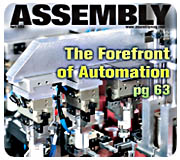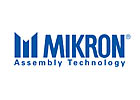
The Custom Automated Systems Group (CASG) consists of companies that serve the automation needs of U.S. manufacturers by producing custom-built assembly and test systems, material removal systems, and material forming and joining systems. The group is part of AMT-The Association for Manufacturing Technology (McLean, VA), and was formed in 1994. CASG currently has more than 50 member companies.
The mission of CASG member companies is to provide products and services that improve the business operations of U.S. manufacturing companies. "Builders of custom assembly systems enjoy a symbiotic relationship with the manufacturers they serve, so they face many of the same business challenges," says Malcolm Mason, AMT's business development director. "In many ways, companies that design and build custom assembly systems are at the forefront of manufacturing innovation, occupying industry's adventurous fringe where engineering creativity is often the mark of success."
Custom builders, by definition, solve specific production problems for specific manufacturers. They don't build standard equipment "to stock"; to the contrary, the projects they tackle are often first-of-a-kind and may never be built again in the same form. Here's a brief look at just a few projects CASG member companies have carried out recently.

Lean Handling for Assembly
There are many aspects of lean manufacturing that are being applied in various ways in product assembly operations. The belief that lean manufacturing principles only apply to high takt time operations has been long forgotten. One of the challenges to lean thinking today is how many parts can be produced per unit of time while still using the versatility of manual operators. The number of times any operator must handle the same part becomes a significant factor in addressing this challenge. Advanced Assembly Automation (Dayton, OH), a Div. of Assembly & Test Worldwide, recently designed and implemented a lean assembly system that truly optimized parts handling for the operator for as many process operations as possible.The highlight station in this system allows the operator to load the parts required for five different processes and achieve a takt time of 23 seconds. According to Jim Diederich, vice president of sales and marketing at Assembly & Test Worldwide, the keys to this success are:
- The operator can load two slightly unwieldy parts simultaneously due to the use of preloaded setup fixtures.
- Other smaller parts are available at the load position in ergonomically positioned pickup points.
- Parts are transferred automatically between process points in the station.
- The operator can perform multiple processes at one fixture point.
The continuing demand to reduce costs, and the need to cope with increasing price pressure, require manufacturers to optimize every step in their processes, says Diederich. This trend has gone on for some time and shows no signs of abating anytime soon. Therefore, manufacturers that use the most efficient mix of machines, combined with the versatility of manual operators, are most likely to succeed.

Redeploy Assets to Get Lean
Spartan Light Metal Products (St. Louis) supplies aluminum and magnesium die castings to automotive customers in the United States, Japan, Mexico and Europe. Spartan also makes die castings for nonautomotive products, such as chainsaws, string trimmers, and appliances.In 2002, Spartan opened a new plant in Mexico, MO, to make magnesium castings, and by 2005 the plant forecast that its existing engine cam cover assembly and test system would run out of production capacity. Because Wes-Tech Automation Solutions (Buffalo Grove, IL) had previously designed and built several automation systems for Spartan, it was the logical candidate to build a new system for semiautomated assembly and testing of cam covers.
Spartan required a low-volume lean cell system to supplement existing capacity during peak demand, and also provide a secondary production source when the main production system was down for maintenance. Space limitations imposed footprint constraints, and even a low-cost, robust, compact and flexible cell, although very important for meeting customer needs, barely met the desired return-on-investment (ROI) criteria for capital equipment. This is a typical hurdle any time a company requires new capacity without having secured the necessary volume in the short term. The solution to this dilemma turned out to be capital asset redeployment. Incorporating existing underutilized or out-of-production capital equipment would reduce the cost of the new cell enough to meet the ROI requirements.
A search of Spartan's warehouses revealed equipment that could be reused in the assembly cell. Once Wes-Tech engineers identified the reusable equipment, they were able to calculate how much money Spartan could save compared with buying new equipment. Both companies subsequently agreed on a bill of materials for the project that would make the best use of existing equipment.
This innovative approach presented two challenges. The first was integrating the performance, and to some extent even appearance, of the older equipment with the new machinery. The second was managing customer expectations for the function and "feel" of the resulting system.
The project was completed in May 2005, on schedule and on budget. Rick Kulla, Spartan's plant manager, says "The project team was very pleased with the resulting cell. The project was on time, met our expectations, and improved margin performance."
The key project milestones were selecting the reusable equipment and getting that equipment rebuilt or refurbished on time with good performance. The key project challenges were meeting the compressed time schedule and coordinating with multiple vendors to refurbish the equipment. Several project management tools were critical to success:
- A well-defined project structure.
- Matching the right resources with the right tasks.
- Frequent program evaluation and review, with appropriate change controls.
- Design failure modes and effects analysis, integrated with the project structure.
- A disciplined issue management process and multidirectional cross-functional communication.

Qualify for FDA Approval
An assembly system used to manufacture medical devices not only needs to meet customer requirements, but must also comply with certain criteria to ensure that it produces safe, high-quality assemblies. These criteria have been developed by the pharmaceutical industry, in compliance with regulations issued by the Food and Drug Administration (FDA). Any device used to administer medications by inhalation, aspiration or injection must be completely safe, accurate and reliable in its operation.These requirements influence not only the design of the device itself, but also that of the assembly system, which often must operate in a clean room environment from class 100,000 to class 10,000. In this environment, the number of particles is carefully monitored, and the premises are equipped with laminar-flow hoods. The areas of the assembly machine through which the product passes must be adequately guarded. Such special guarding creates a restricted work area to reduce the risk of contamination. In addition, the machine will need to be cleaned frequently to prevent the accumulation of particles that could contaminate the device being assembled.
Leading pharmaceutical companies have developed a document known as the Good Manufacturing Practices (GMP) guide, to be used by companies building assembly systems and other automation equipment for the pharmaceutical industry. This guide outlines the engineering, manufacturing and documentation standards that should be followed to achieve FDA validation of automated systems for pharmaceutical products.
To obtain FDA approval, an equipment manufacturer must prove that the assembly system operates in accordance with industry specifications and quality standards, and that these standards can also be maintained. The manufacturer is required to provide detailed documentation showing that the required test procedures have been followed, and the test results.
Approval procedures follow a four-stage qualification process:
- Design qualification. This initial stage includes engineering and development of the assembly system in accordance with GMP requirements.
- Installation qualification. This stage verifies that the system has been constructed and installed in compliance with requirements, and that the calibration systems are accurate.
- Operational qualification. This stage verifies that the assembly system operates properly and complies with all requirements. These tests are conducted in idle mode, or using a placebo. Upon completion, a protocol on the preliminary testing results is signed.
- Performance qualification. Once the machine has been installed on the client's premises, this stage verifies that the system, in operational mode and with production parts, operates correctly and complies with all necessary requirements. Upon completion of this phase, a protocol on the final testing of the system is signed.
One significant benefit for the client is that when the final performance qualification stage gets underway, the company already has the essential documentation to be provided to the FDA. This documentation will have already been prepared by Mikron based on the outcomes of the prior stages in the qualification process. Another benefit is the time the client saves between delivery of the machine to his premises and the point at which the application is submitted to the FDA for approval, resulting in a considerable lead-time reduction.
Retool for Savings
What does a major automotive components manufacturer do when a customer cancels a program after only a few months of production? If the assembly platform is highly standardized, the manufacturer simply sends it back to the machine builder to be retooled for a new product. This approach recently saved one automotive manufacturer a considerable amount of capital.This particular line was completely retooled by its original builder, Bodine Assembly & Test Systems (Bridegeport, CT), to produce transmission control valves. The retooled line includes two high-speed synchronous systems that produce two transmission control valves simultaneously on demand. The fully integrated line includes coil winding, terminal insertion, encapsulation and final assembly, as well as vision inspection and electrical testing.
Finished valves are then assembled into three different versions of the transmission main control module on an asynchronous robotic FlatTop assembly platform. Each control module is populated with three valves of each type, for a total of six valves per module, which are placed in a variety of configurations and then individually oriented. Robots measure insertion force applied to each valve, as well as insertion depth. Force measurement ensures that valves are correctly seated, and exact depth measurement is critical to performance of the control module once it is installed in a transmission. A final vision test verifies that the two types of valves are in the correct locations and orientations before the main control body is transferred downstream.
Coils on Demand
As the instruments used in arthroscopic surgery, and the catheter devices used in vascular operations, become smaller and smaller, the coil elements of these devices become very small, fragile and difficult to handle. Today the majority of these coils are made in batches, delivered in bulk to an assembly area and then manually assembled into the device. When the coil diameter approaches 0.032 inch, the coil wire diameter is as small as 0.003 inch, and the coils have open pitches and varying profiles, assembly becomes a real challenge. The first difficulty is extracting an individual coil from a random batch of coils. The second is to orient it correctly for assembly, and the third is to place it the correct position for insertion. In addition, the secondary operations must be performed precisely, repeatedly and quickly.The best way to meet this challenge is to eliminate the first two steps from the assembly operation, and combine them with the coil-making process. A coil production system called On-Demand has been developed by the Sleeper Div. of Kinefac Corp. (Worcester, MA) to make the coils and feed them directly to an automated assembly machine.
The system typically consists of a Micro-Dereeler to feed wire, a Micro-Coiler deflection coiling machine, and coil capture and transfer devices. The coiling machine can produce complete, cutoff coils of variable pitch and diameter as small as 0.008 inch in diameter from wire as small as 0.0015 inch in diameter at rates up to 1 per second. The capture and transfer systems are based on semi-standard units that can be modified and adapted to meet user requirements. The components of the On-Demand system can all be mounted directly to an assembly machine base, with the control screen and keyboard positioned as required by the assembly system layout. Alternatively, the system can be mounted on a two-position movable platform to position it for either setup or assembly operation.
Once formed and cut off on the Micro-Coiler, coils are captured in the as-coiled orientation and transferred directly by a track, with air assist, to a multipocket carrier that is integrated with the automatic assembly magazine. The coils generally lie in the carrier pockets with their axes horizontal and are picked out of the carrier pockets by a pick-and-place unit. Such units typically use a transfer wire that is pushed into the center of the coil to lift the coil and place it correctly for the next assembly operation.
For stiffer coils, a variant of the system has the transfer wire placed in a position so that its end is in line with the axis of the coiling machine arbor. A coil is wound until its inside diameter is around the end of the transfer wire. That coil is then cut off and moved axially along the transfer wire. This process continues until the transfer wire is full, and that group of coils is transferred to the final assembly point.